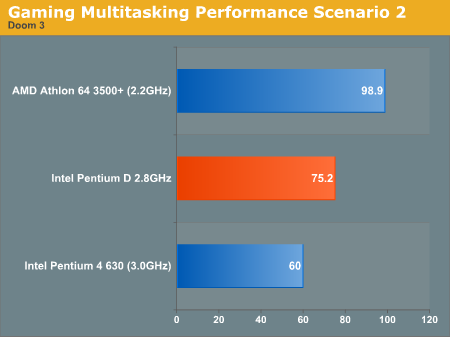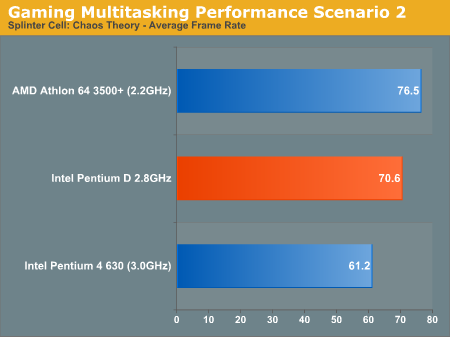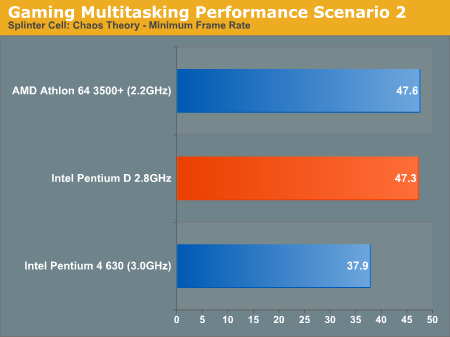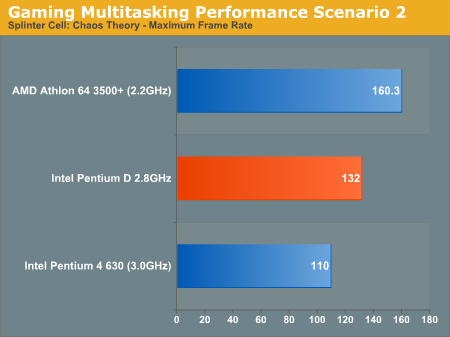Intel Dual Core Performance Preview Part II: A Deeper Look
by Anand Lal Shimpi on April 6, 2005 12:23 PM EST- Posted in
- CPUs
Gaming Multitasking Scenario 2: DVD Shrink
For our next test, we wanted to do something a little less strenuous, so we only ran one background task: DVD Shrink. We left DVD Shrink at its default low priority and went ahead with our benchmarks:

Thanks to DVD Shrink behaving and running with a low priority, our gameplay was largely unaffected on the Athlon 64. The performance dropped less than 3% in Doom 3.
What's very interesting, however, is that the Pentium 4 630 takes a huge performance hit with DVD Shrink running in the background. Despite being set to a low priority, since Hyper Threading allows both the DVD Shrink thread and Doom 3 thread to execute concurrently, they both contend for the same microprocessor execution resources. This happens to be one case where Hyper Threading is actually very bad for performance, as the OS has no idea that its scheduling is actually hurting the CPU's performance severely.



The performance gap between the Pentium D and the Athlon 64 actually closes quite a bit under Splinter Cell. The minimum frame rates are now identical, although the maximum frame rates are clearly higher on the AMD system.
Once again, HT has a negative impact in this case on the Pentium 4 630.
Just for kicks, we decided to turn off DVD Shrink's low priority setting to see what impact that would have on performance. The low priority mode of DVD Shrink basically makes it transparent to gaming. Unchecking this option definitely changes things, it wouldn't even start on the Athlon 64 system.
It eventually ran on the Pentium D system after waiting several minutes for it to start, and even then, performance wasn't acceptable. It just goes to show you that dual core isn't Superman; it does have its limits.










106 Comments
View All Comments
JoKeRr - Wednesday, April 6, 2005 - link
the power consumption is a series mofo here.hm, with a P4 EE or PDEE, with 2 6800Ultra or GT, you're definitely expecting an oven case.
Wonder how those dualcores overclock-->that should help to make up the single thread performance. On the other hand, Clearly HyperThreading is GOOD, but AMD still says NO.
Jeff7181 - Wednesday, April 6, 2005 - link
Great article. Well done guys.The only thing I have to question is how a dual core Athlon-64 at encoding. On the last page you say, "For encoding performance, you still can’t beat the Pentium D. Even a dual core Athlon 64 isn’t going to help enough in that area."
What makes you think that when the 2.2 GHz Athlon-64 is RIGHT behind the 3.0 GHz Pentium 4 630?
Everything I've read so far has told me that the Athlon-64 should scale better than the Pentium 4 as far as dual cores are concerned... so... what exactly are you basing your opinion that even a dual core Athlon-64 won't help in encoding???
Lonyo - Wednesday, April 6, 2005 - link
Does http://www.anandtech.com/cpuchipsets/showdoc.aspx?... page have an error?It lists the PD 3.2, P4 3.73 EE and the PD 3.2 EE, not the 3 CPU's montioned in the article. Wrong graph maybe.
Rys - Wednesday, April 6, 2005 - link
H isn't even near P on the keyboard...michaelpatrick33 - Wednesday, April 6, 2005 - link
Holy crispy power and cook my eggs in true multitasking while I surf the net Batmansmn198 - Wednesday, April 6, 2005 - link
I guess it makes sense that NCQ would help when multitasking. I assume that this would be the same on single cores as well? The new focus on responsiveness is a good move IMO. The time to switch between apps and redraw the screen and clicking on menus and buttons is what frustrates me when I am multitasking.